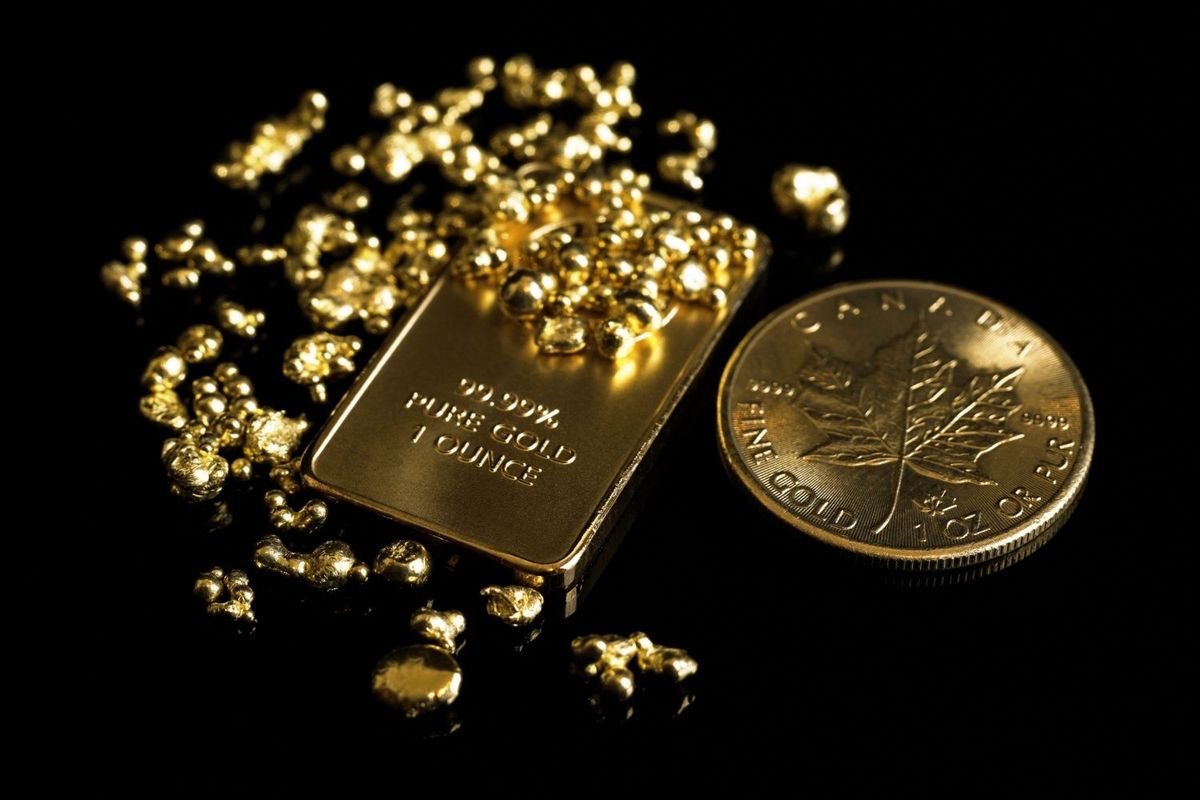A Guide to Investing in Physical Gold
Oct. 08, 2025 09:40AM PST
Adding physical gold to your investment portfolio? Here are some tips you need to know, including how best to buy, sell and store it.

MIKE MANIATIS / Shutterstock
Gold is known as an attractive safe-haven investment and has been used to store wealth during volatile times through history.
It has interesting currency-like tendencies, and retains its purchasing power better than paper currencies.
For that reason, gold market analysts typically recommend that investors build a diversified portfolio with a portion of their wealth in gold bullion. Here the Investing News Network explains what's involved in building and managing a physical gold portfolio.
In this article
- What physical gold product is best to buy?
- What is the difference between the gold spot price and retail price?
- Where can investors buy physical gold?
- How and when to sell physical gold?
- How should physical gold be stored?
- Is it possible to purchase physical gold through the futures market?
- What are some alternatives to physical gold?
What physical gold product is best to buy?
Physical gold investors are generally looking for items that are 0.999 fine. Most gold bullion coins fit this description, including the Canada Gold Maple Leaf, the South African Krugerrand and the American Buffalo Gold coin. American Gold Eagles are popular with investors, but they are have a much lower purity at 91.67 percent.
An alternative to gold coins is gold rounds, which are also 0.999 fine but are not legal tender. This makes them slightly cheaper than gold coins, as the premium for gold coins is higher because of the credibility that comes from being fabricated by government mints.
Both gold coins and gold rounds come in various sizes, usually ranging from 1/10 ounce to 1 ounce, though other less common sizes are available.
Gold bars are another popular option. These also come in a variety of sizes, and as choices can range from a 1 gram bar to 400 ounce bar, this category of products can accommodate a range of investors. They are also 0.999 fine.
When the objective is to get the most metal for the least money, it’s generally best to shop for gold rounds and gold bars, which tend to be cheaper than gold coins of the same weight.
Another factor that may need to be considered is the amount to be invested. Bars may be the best option for large investments since bigger sizes are available. Further, it is often easier to manage large products than it is to manage an array of smaller gold items.
However, physical gold investors also need to give forethought to when they may want to sell their gold. Large products will require liquidating a more sizeable portion of one’s gold portfolio, and such products may be more difficult to sell in some instances. Individuals making ongoing or significant investments may want to consider purchasing gold in various weights.
What is the difference between the gold spot price and retail price?
Investing in physical gold is often oversimplified, and the misconceptions can begin with pricing.
A spot price by definition is the cost of immediate delivery, and is a way to gauge the legitimacy of an ask or retail price. The spot price is what is reported on and what most gold price charts will show. Unfortunately, some investors don't realize until they make their first purchase that the spot price is not what one actually pays for physical gold.
The retail price of gold is based off the spot price but includes a markup, also called a premium. In addition to premiums, there are numerous other expenses investors should be prepared to pay when purchasing pure gold, including shipping, handling and insurance. In some instances, prices may be higher for individuals who choose to pay with a credit card.
There may also be processing fees to own the yellow metal or fees for small lot purchases. On the other hand, gold prices are sometimes lower for those purchasing larger quantities.
Where can investors buy physical gold?
Gold buying can be done through government mints, private mints, precious metals dealers and even jewelry stores. Some of these locations will offer numismatic coins or other gold items geared toward collecting and gift giving, which bullion investors should generally avoid. These products are for play in a different ball game and are not what the average gold investor needs.
When choosing where to buy gold, it is again best to give thought to reselling it. Some businesses that sell gold will also buy it back. Some will even buy gold that they didn’t sell, but may pay lower prices.
Furthermore, premiums and fees are not one size fits all when buying physical gold. Different sellers may offer the same items at different prices, so investors should take the time to find the best deal.
How and when to sell physical gold?
Investors looking to sell their gold bullion and coins should do so at bullion exchanges when possible, as those will offer the best value for the metal.
Individuals who want to sell their gold quickly may consider “we buy gold” businesses as a convenient alternative. However, while these businesses can serve as a quick source of liquidity, they are usually not the best option, as their underlying business strategy often involves making lower-than-average offers, meaning you will receive less than you would at a bullion exchange or mint.
As for when to sell your gold, there are a few other things to take into consideration.
Just as buying gold often provides investors with a pricing wakeup call, investors who decide to sell are sometimes surprised at the prices they receive. That is because the buyback price, or bid, is lower than the asking price. The difference between the two is referred to as the spread, and it is a loss that the seller initially bears.
For example, if an investor pays US$3,700 for a 1 ounce Canadian Maple Leaf from a bullion exchange and wanted to sell it back right after, the exchange's buying price may only be US$3,610. The spot price is generally in the middle of the two.
Furthermore, there are usually other costs involved with selling gold, including shipping, insurance and liquidation fees. Some businesses have minimum purchase requirements, and depending upon payment arrangements, it may be necessary for the investor to pay bank wire fees or postage to receive a check.
The reality is that, given the spread and the costs associated with acquiring and selling gold, a sharp price move is generally needed to turn a profit in the short term. Investors are encouraged to consider building positions in physical gold as a long-term investment, possibly even for retirement savings.
How should physical gold be stored?
Determining the best storage option involves weighing risks against costs.
Paying for secure storage eats into profits from the metal’s gains, so some people choose to store their gold at home or in their office. In theory, that is the riskiest option as it involves the highest potential for loss due to theft or disaster. But in many instances these risks are not substantial enough to justify the cost of other storage options.
For home storage of smaller amounts of gold, mitigate theft risk by keeping it hidden somewhere that is less likely to be discovered. Of course, a sturdy home safe comes with an upfront cost and a footprint, but it can help protect valuables from theft and some disasters.
As mentioned, gold can also be stored in a depository or safe deposit box for a cost. If an investor chooses this route, there are a few things to consider. Rates can vary between banks, so price comparison is important. Additionally, the contents of safety deposit boxes in financial institutions are generally not insured.
Last but not least, some banks do not technically permit the storage of bullion, so it's important to make sure it's possible before signing a terms and conditions agreement. The information should be listed in the agreement as well.
Is it possible to purchase physical gold through the futures market?
A gold futures contract is an agreement to buy or sell gold on a date in the future for a price that is determined when the contract is initiated. The futures market is often referred to as an arena for paper trading. Generally, the bulk of the activity is just that, as metal is not actually exchanged and settlements are made in cash.
However, the futures market can also be an arena for purchasing physical gold. That is not to suggest that it is the best source of metal for all investors as it may not increase one’s purchasing power.
Obtaining gold through the futures market requires a large investment and involves a list of additional costs. The process can be complicated, cumbersome and lengthy, which is why this option is considered best for highly experienced market participants.
What are some alternatives to physical gold?
Purchasing metal is not the only way to gain exposure to physical gold. Indeed, the popularity of exchange-traded funds (ETFs) underscores how easily people can get into the gold market without actually owning physical gold.
Gold ETFs may track gold stocks or they may track the gold spot price. Investors looking for the closest analog to buying physical gold will likely want to focus on the latter. However, it's important to be aware that ETFs that follow the gold price are generally not vehicles to acquire gold, even if they are physically backed.
One advantage of gold ETFs is that they can be easier to trade than physical gold. Some investors choose to hold a set amount of physical gold at all times and use ETFs to trade the metal's ups and downs.
To learn about your options, take a look at our lists of North American gold ETFs and gold ETFs on the ASX.
This is an updated version of an article originally published by the Investing News Network in 2012.
Don’t forget to follow us @INN_Resource for real-time news updates!
Securities Disclosure: I, Lauren Kelly, hold no direct investment interest in any company mentioned in this article.
From Your Site Articles
- 4 Ways to Invest in Gold for Retirement (Updated 2024) ›
- What are Gold Futures? | INN ›
- How to Use Gold Investments as a Hedge | INN ›
- 5 Basic Facts About Gold ›
- An Overview of Gold Investing and Prices | INN ›
Related Articles Around the Web
https://twitter.com/INN_Resource
https://www.linkedin.com/in/lauren-kelly-16a369b3
lkelly@investingnews.com





